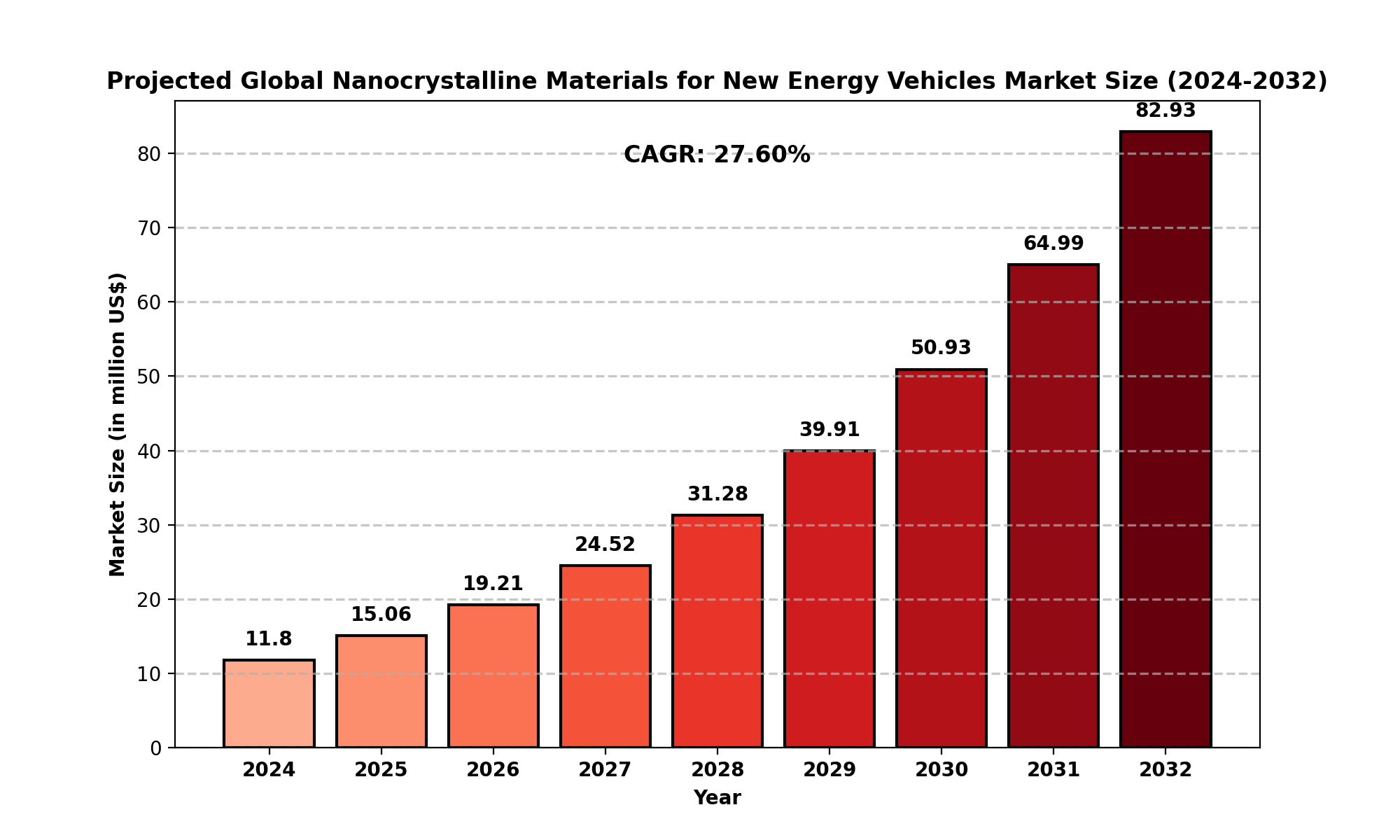TOP CATEGORY: Chemicals & Materials | Life Sciences | Banking & Finance | ICT Media

Download Report PDF Instantly
Report overview
Nanocrystalline materials are advanced crystalline materials characterized by their particle size, which ranges from 1 to 100 nanometers. Their unique microstructure and size effect confer exceptional physical, chemical, and mechanical properties, making them highly versatile and valuable across various applications. Specifically, in the field of new energy vehicles (NEVs), nanocrystalline materials are indispensable due to their superior magnetic and electrical properties. They play a pivotal role in motors, inductors, transformers, and wireless charging systems, significantly enhancing the performance of power transmission and energy conversion components.
The global Nanocrystalline Materials for New Energy Vehicles Market was estimated at USD 11.80 million in 2024 and is projected to surge to USD 82.93 million by 2032, reflecting an impressive compound annual growth rate (CAGR) of 27.60% during the forecast period.
In North America alone, the market size was valued at USD 4.70 million in 2024, with a projected CAGR of 23.66% between 2025 and 2032.
These growth figures underscore the increasing adoption of nanocrystalline materials as NEV technologies advance and the global push towards sustainable energy solutions accelerates. The expansion of electric vehicle production, coupled with continuous innovations in material science, will further propel this market.

Drivers
Advancements in Electric Vehicle Technologies: As the demand for efficient and high-performing electric vehicles rises, the superior magnetic and electrical properties of nanocrystalline materials are becoming increasingly vital in powertrain components.
Sustainability Goals: Governments and industries worldwide are striving to reduce carbon footprints, driving the adoption of NEVs and, consequently, the materials that enhance their performance.
Technological Innovations: Continuous research in material science is unlocking new potential applications for nanocrystalline materials, expanding their utility beyond traditional uses.
Restraints
High Production Costs: The manufacturing processes for nanocrystalline materials remain expensive, posing a significant barrier to mass adoption.
Limited Awareness: Despite their benefits, many industries lack awareness of the advantages offered by nanocrystalline materials, particularly in emerging markets.
Opportunities
Expansion into Emerging Markets: Rapid industrialization and the growing adoption of electric vehicles in regions such as Asia-Pacific and South America present untapped opportunities for market growth.
Integration with Renewable Energy Systems: Beyond NEVs, nanocrystalline materials hold potential in renewable energy applications, such as solar power inverters and wind turbines.
Challenges
Complex Manufacturing Processes: Producing nanocrystalline materials with consistent quality and properties is technically challenging.
Supply Chain Constraints: Dependence on raw material availability and geopolitical factors can disrupt the supply chain.
North America
North America, with an estimated market size of USD 4.70 million in 2024, is expected to witness substantial growth due to robust government support for clean energy initiatives and advancements in NEV technologies. The United States leads the region, driven by high R&D investments and the presence of major automotive players.
Europe
Europe is poised for significant growth, driven by stringent emissions regulations and the region’s strong commitment to electrification. Countries like Germany, the UK, and France are at the forefront of adopting nanocrystalline materials in NEV components.
Asia-Pacific
Asia-Pacific dominates the market, led by China’s massive NEV production capacity and strong government incentives. Japan and South Korea also contribute significantly due to their advanced automotive and electronics industries.
South America and MEA
South America and the Middle East & Africa (MEA) are emerging markets, where growing NEV adoption and industrialization are expected to drive demand for nanocrystalline materials.
Key Companies
Proterial
Bomatec
Vacuumschmelze
Qingdao Yunlu Advanced Materials
Henan Zhongyue Amorphous New Materials
Foshan Huaxin Microlite Metal
Londerful New Material
Orient Group
Zhaojing Electrical Technology
OJSC MSTATOR
Advanced Technology & Materials
Vikarsh Nano
Nippon Chemi-Con
These companies are at the forefront of innovation, focusing on expanding their product portfolios and strengthening their global presence through strategic partnerships, mergers, and acquisitions.
Motor Core
Inductor
Transformer
Wireless Charging System
Other
Metal Nanocrystalline Materials
Metal Oxide Nanocrystalline Materials
Other
North America (USA, Canada, Mexico)
Europe (Germany, UK, France, Russia, Italy, Rest of Europe)
Asia-Pacific (China, Japan, South Korea, India, Southeast Asia, Rest of Asia-Pacific)
South America (Brazil, Argentina, Columbia, Rest of South America)
Middle East and Africa (Saudi Arabia, UAE, Egypt, Nigeria, South Africa, Rest of MEA)
What is the current market size of Nanocrystalline Materials for New Energy Vehicles?
The global market size was estimated at USD 11.80 million in 2024 and is projected to grow to USD 105.81 million by 2032.
Which are the key companies operating in the Nanocrystalline Materials for New Energy Vehicles market?
Key companies include Proterial, Bomatec, Vacuumschmelze, Qingdao Yunlu Advanced Materials, and Nippon Chemi-Con, among others.
What are the key growth drivers in the Nanocrystalline Materials for New Energy Vehicles market?
Major drivers include advancements in electric vehicle technologies, sustainability goals, and ongoing material science innovations.
Which regions dominate the Nanocrystalline Materials for New Energy Vehicles market?
Asia-Pacific leads the market, followed by North America and Europe.
What are the emerging trends in the Nanocrystalline Materials for New Energy Vehicles market?
Emerging trends include integration with renewable energy systems, expansion into emerging markets, and advancements in manufacturing processes to reduce costs.
Industry drivers, restraints, and opportunities covered in the study
Neutral perspective on the market performance
Recent industry trends and developments
Competitive landscape & strategies of key players
Potential & niche segments and regions exhibiting promising growth covered
Historical, current, and projected market size, in terms of value
In-depth analysis of the Nanocrystalline Materials for New Energy Vehicles Market
Overview of the regional outlook of the Nanocrystalline Materials for New Energy Vehicles Market:
Access to date statistics compiled by our researchers. These provide you with historical and forecast data, which is analyzed to tell you why your market is set to change
This enables you to anticipate market changes to remain ahead of your competitors
You will be able to copy data from the Excel spreadsheet straight into your marketing plans, business presentations, or other strategic documents
The concise analysis, clear graph, and table format will enable you to pinpoint the information you require quickly
Provision of market value data for each segment and sub-segment
Indicates the region and segment that is expected to witness the fastest growth as well as to dominate the market
Analysis by geography highlighting the consumption of the product/service in the region as well as indicating the factors that are affecting the market within each region
Competitive landscape which incorporates the market ranking of the major players, along with new service/product launches, partnerships, business expansions, and acquisitions in the past five years of companies profiled
Extensive company profiles comprising of company overview, company insights, product benchmarking, and SWOT analysis for the major market players
The current as well as the future market outlook of the industry concerning recent developments which involve growth opportunities and drivers as well as challenges and restraints of both emerging as well as developed regions
Includes in-depth analysis of the market from various perspectives through Porter